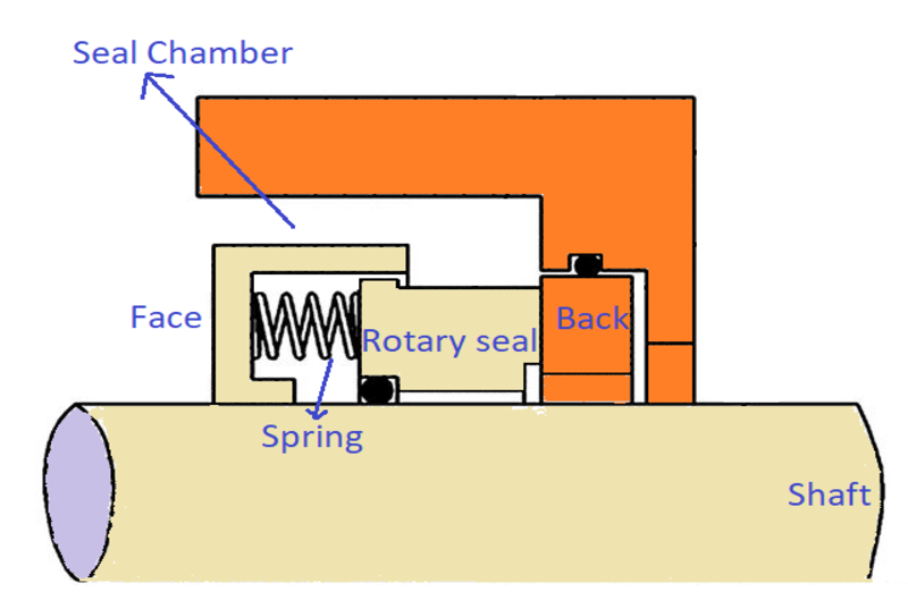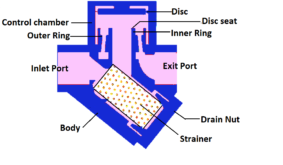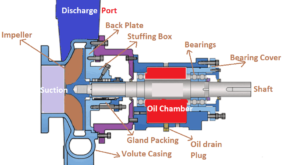Table of Contents
Properties of Mechanical Seal Face Materials (Mechanical Seal of a Centrifugal Pump-Part 4)
The right choice of mechanical seal face material judges the life of a mechanical seal primarily since it is the portion of the mechanical seal that is subjected to wear due to rubbing. The right choice comes from a proper understanding of the fundamental properties of a seal face material and geometrical considerations like flatness. The focus of this blog is on the properties of mechanical seal face materials.
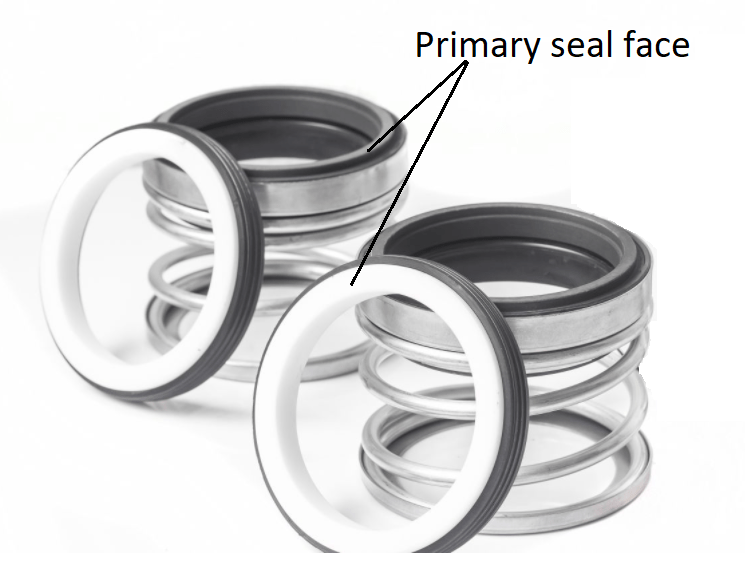
Goals
- The flatness of a Mechanical Seal Face
- How to choose the right seal face material combination?
- Fundamental Properties Required for a Seal Face Material
Flatness of a Mechanical Seal Face
Flatness: As per ASME, flatness is defined as a tolerance zone within which the surface must lie. Flatness indirectly represents the waviness of a surface. Consider Figure 1, choose the available topmost point on the surface and draw a plane parallel to the surface such that the chosen topmost point shall lie in the plane. Now choose the available bottommost point on the same surface and draw a plane same as the above. The vertical gap between these two parallel planes is called the tolerance zone as shown in Figure 1. The lower the gap between two planes, the higher the flatness value. Specifically, flatness is a 3D version of surface straightness.
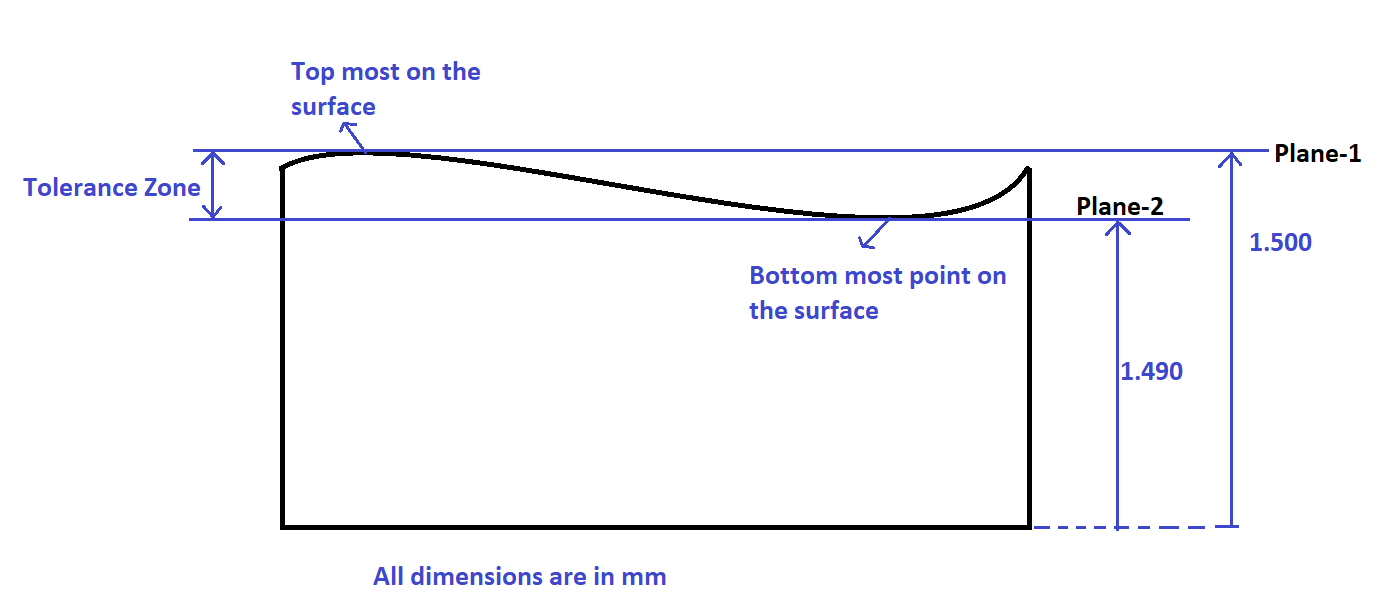
Flatness is responsible for perfect sealing between the primary and mating rings of a mechanical seal. As we know the primary sealing of a mechanical seal is achieved by rubbing the rotating primary ring against a stationary mating ring as shown in the figure-2. The flatness of two mating rings must be high such that complete area contact can be achieved between the contact surface, hence the fluid leak through the junction between the mating rings can be arrested. In general, the flatness of the seal face is very high such that it cannot be measured using mechanical instruments and it is measured in terms of helium bands. Practically, the flatness of a seal face is in the range of 1 to 3 helium bands. i.e., 0.3 µ to 0.9 µ.

How To Choose the Right Seal Face Material Combination for a Mechanical Seal?
First, let us know what are the various mechanical seal face material combinations available in the industry. There are two seal face combinations available. They are
- Soft Vs Hard
- Hard Vs Hard
Mechanical seal face material combination in the sense, choosing the right material for the primary ring and mating ring based on their application such that premature seal failure can be avoided. The softness and hardness of a seal face are relative to each other.
In general, softer seal faces are narrower and harder seal faces are wider such that softer seal face wears first by maintaining the integrity of harder seal face.
Soft Vs Hard Combination
Soft Vs Hard combination is preferred under boundary and mixed lubrication modes which demand the self-lubrication property of a seal face material. Because, in boundary lubrication, the contacting faces of the seal will have little or no separation whereas in the case of mixed lubrication, asperities of the contacting surface meet occasionally. To avoid wear due to contact between faces, the face material should have self-lubrication properties. Boundary lubrication mode is predominant in low-speed equipment and mixed lubrication mode is predominant in medium speeds. In both the lubrication modes, seal-face contact is inevitable.
Applications of Soft Vs Hard Combination
The soft Vs Hard combination is preferred in the following applications
- The seal cooling fluid enters the sealing gap as liquid and leaves as vapour or gas (due to frictional heat) resulting in contact between seal faces.
- The pumping fluid that is being pumped is very clean so that the life span of the softer ring can be increased.
- The fluid being pumped has a very low viscosity.
- Improved Sealing Performance: The softer seal ring fills in any minor imperfections between the seal faces, enhancing the sealing effectiveness and reducing leakage.
Hence wherever there is a possibility of contact between seal faces, soft vs hard combination is preferred.
Hard Vs Hard Combination
The Hard Vs Hard combination is preferred in the hydrodynamic mode of lubrication where a thin fluid film separates the seal faces. Hydrodynamic lubrication mode is predominant in high-speed equipment.
Applications of Hard Vs Hard Combination
A hard vs hard combination is preferred when the fluid being pumped contains abrasive solid particles that could damage the seal faces. The seal face material must be harder than abrasive particles.
Fundamental Properties Required for a Mechanical Seal Face Material
The Following represents the necessary properties that a mechanical seal face material should contain. An ideal mechanical seal face material will have all the following properties.
- Good Tribological Property
- High Thermal Conductivity
- High Elastic Modulus
- Good Chemical Resistance
- Light Weight
- Good Thermal Shock Resistance
- Self-lubricating property
- Good Mechanical Strength
- High Surface Hardness
Some of the above-mentioned properties are discussed briefly.
Surface Roughness of a Mechanical Seal
A smooth surface with low surface roughness minimizes the gaps between the seal ring and the counterface, reducing the opportunities for fluid to leak between them. Generally, a surface roughness range of 0.4 to 1.6 micrometres (Ra – average roughness) is considered suitable for many mechanical seal applications.
Thermal Shock
The ability of a material to undergo rapid temperature changes without failing is called thermal shock resistance. When a material has different temperatures at different locations, the localized portions undergo unequal thermal expansion due to non-uniform temperature distribution. This results in the generation of localized stresses due to unequal thermal expansion. If the stress exceeds the material strength, crack formation occurs. Thermal shock is predominant in brittle material whereas ductile material undergoes plastic deformation to accommodate these stresses. Seal rings of mechanical seals need to have a high level of thermal shock resistance. This is because they are often subjected to rapid changes in temperature, such as when a pump is started or stopped.
A seal ring that is used in a pump that is frequently started and stopped will need to have a higher level of thermal shock resistance than a seal ring that is used in a pump that is run continuously.
![]()
A seal ring having low coefficient of thermal expansion, do not expand or contract very much when the temperature changes, which helps to prevent them from becoming damaged.
Elastic Modulus
As we know from the fundamentals of the strength of the material, elastic modulus represents the ability of the material to resist deformation i.e., stiffness. If the material has a high elastic modulus, it can resist face distortion so that contact between seal rings is ensured even under higher stuffing box pressure.
Thermal Conductivity
Thermal conductivity is defined as the ability of a material to transfer heat. The frictional heat generated due to rubbing of the primary ring and mating ring must be transferred to the surrounding coolant so that the seal face temperature will be under control and the hardness of the seal face will not deteriorate. This is possible when the seal face material has sufficient thermal conductivity.
Commonly Used Mechanical Seal Face Materials
The following materials are commonly preferred as seal face material since it full fills some/most of the above-mentioned fundamental properties. They are
| Hard Face Materials | Soft Face Materials |
|---|---|
Ceramic (Aluminium Oxide or Alumina) | Carbon-graphite |
Tungsten Carbide | Glass Filled PTFE (GF-PTFE) |
Silicon Carbide |
Carbon- Graphite
- Carbon exists in two allotropic forms. They are graphite and diamond.
- Graphite is of Hexagonal Close Packed (HCP) crystal structure, hence it is preferred in dry or mixed lubrication modes due to the self-lubrication property.
- Good compressive strength.
- Relatively low Elastic Modulus, hence it is not preferred in high-pressure applications since its seal face is prone to distortion.
- Not preferred in abrasive applications since the surface hardness is relatively less.
| Hardness | 100 shore A |
| Melting Temperature | 3600 |
| Elastic Modulus | 23 Gpa |
| Thermal conductivity (@Room Temperature) | 11 W/m.K |
| Density | 1.8 g/cc |
| Coefficient of thermal expansion (@Room Temperature) | |
| Thermal shock resistance | 10360 W/m |
Ceramic
- The primary material is Aluminium Oxide or Alumina (99.5% is
 composition).
composition). - Aluminium oxide is known for its hardness and strength. Hence it has good wear resistance characteristics.
- It is chemically inert because Aluminium Oxide is the highly stable oxide of Aluminium.
- Poor thermal shock resistance.
| Hardness number, Vickers | 2500 |
| Melting Temperature | 2000 |
| Elastic Modulus | 365 Gpa |
| Thermal conductivity (@Room Temperature) | 30 W/m.K |
| Density | 3.9 g/cc |
| Coefficient of thermal expansion (@Room Temperature) | |
| Thermal shock resistance | 5718 W/m |
Tungsten Carbide (WC)
- The primary composition is Tungsten and Carbon.
- Tough material because hard carbide particles are bonded together with the help of ductile material.
- Good wear resistance.
- Good corrosion resistance.
- Due to its high elastic modulus, it is preferred in high-pressure applications so that seal face distortion can be prevented.
| Hardness number, Vickers | 1500 |
| Melting Temperature | 2870 |
| Elastic Modulus | 670 Gpa |
| Thermal conductivity (@Room Temperature) | 88 W/m.K |
| Density | 15.7 g/cc |
| Coefficient of thermal expansion (@Room Temperature) | |
| Thermal shock resistance | 47930 W/m |
Silicon Carbide (SiC)
- The primary composition is Silica + Carbon.
- Highly wear resistant due to its hardness.
- Good thermal shock resistance.
- Good thermal conductivity.
- Low coefficient of friction, hence the amount of frictional heat generated is relatively less.
- Low toughness, hence it can be damaged easily by any mechanical means.
- Silicon Carbide is a widely preferred mechanical seal face material for abrasive applications because of its hardness.
| Hardness number, Vickers | 3000 |
| Melting Temperature | 2730 |
| Elastic Modulus | 400 Gpa |
| Thermal conductivity (@Room Temperature) | 200 W/m.K |
| Density | 3.2 g/cc |
| Coefficient of thermal expansion (@Room Temperature) | |
| Thermal shock resistance | 59120 |
Poly Tetra Fluoro Ethylene (PTFE)
- Self-lubricating property of PTFE enables it in dry lubrication applications.
- PTFE is chemically inert to almost all chemicals.
- But due to its low strength (i.e.PTFE deforms easily under load) and creep tendency, its application is limited. However, the mechanical strength is increased by the addition of glass fibres to the PTFE.
- Relatively low thermal conductivity.
- Not preferred in abrasive applications due to relatively low hardness.
| Hardness | 72.5 shore D |
| Melting Temperature | 327 |
| Elastic Modulus | 1.32 Gpa |
| Thermal conductivity (@Room Temperature) | 0.4 W/m.K |
| Density | 2.2 g/cc |
| Coefficient of thermal expansion (@Room Temperature) | |
| Thermal shock resistance | – |
